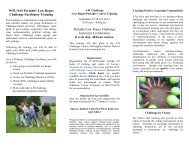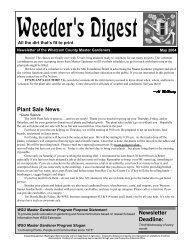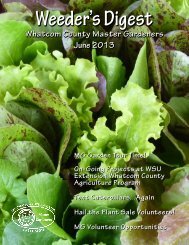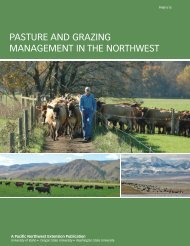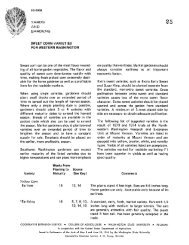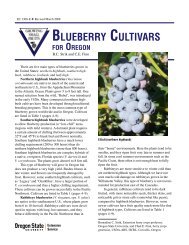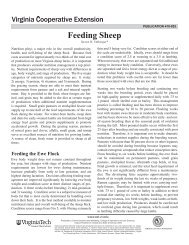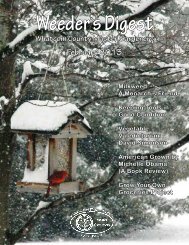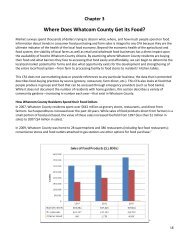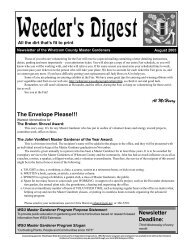Late Blight book - University of Idaho
Late Blight book - University of Idaho
Late Blight book - University of Idaho
You also want an ePaper? Increase the reach of your titles
YUMPU automatically turns print PDFs into web optimized ePapers that Google loves.
PNW 555A Pacific Northwest Extension Publication<strong>University</strong> <strong>of</strong> <strong>Idaho</strong> • Oregon State <strong>University</strong> • Washington State <strong>University</strong>Managing <strong>Late</strong> <strong>Blight</strong> on IrrigatedPotatoes in the Pacific NorthwestWilliam H. Bohl, Philip B. Hamm, Phillip Nolte, Robert E. Thornton, and Dennis A. JohnsonINTRODUCTION<strong>Late</strong> blight, a disease caused by the organismPhytophthora infestans, has been one <strong>of</strong> the most damagingplant diseases worldwide. Until the early 1990s,only a single genotype or strain—A1 mating type,metalaxyl (Ridomil®)-sensitive—called US-1, was presentin North America. When metalaxyl was introduced inthe 1970s, the disease was relatively easy to control withthis chemical.In the early 1990s, other genotypes such as US-8 andUS-11, which are insensitive to metalaxyl, began spreadingacross the potato-production areas <strong>of</strong> North America.Unfortunately, US-8 and US-11 had characteristics thatdiffered significantly from those <strong>of</strong> US-1. Most notably,they were better able than US-1 to cause late blight onpotato—commonly referred to as being more aggressive.Sexual recombination between A1 and A2 mating typesthat occur by chance in the same field (for example, betweenUS-1, an A1 mating type, and US-8, an A2 matingtype) can result in additional genotypes that can also beaggressive and metalaxyl-resistant. Data suggest the development<strong>of</strong> US-11 is from one <strong>of</strong> these chance events.The occurrence <strong>of</strong> new genotypes <strong>of</strong> P. infestans has resultedin increased levels <strong>of</strong> disease and higher costs <strong>of</strong>control throughout the United States, especially in themajor potato-producing states <strong>of</strong> <strong>Idaho</strong>, Oregon, andWashington.This publication discusses the use <strong>of</strong> an integrated managementprogram for late blight on irrigated potatoes inthe Pacific Northwest, including cultural practices, hostresistance, disease forecasts, and chemical applications.Definitions <strong>of</strong> technical terms are included at the end.Foliar symptomsLeaf lesions are circles or semi-circles, <strong>of</strong>ten surroundedby a light green to yellow halo (figure 1). Lesions aremore likely to begin at the leaf edge than in the middle<strong>of</strong> the leaf. Active late blight lesions commonly have whitemycelium growing on the underside <strong>of</strong> infected leaves(figure 2). The mycelium can be seen particularly easilyon most leaves in the morning hours when dew is presentand, later in the day, on leaves found lower in the canopywhere humidity is higher. <strong>Late</strong> blight lesions, unlike those<strong>of</strong> early blight (figure 3), will grow through leaf veins;Figure 1. <strong>Late</strong> blight lesion on a potato leaf has a darkbrownarea bordered by a light green to yellow halo. Photo byPhilip B. HammLATE BLIGHT SYMPTOMSRecognizing symptoms and thoroughly understandingthe biology <strong>of</strong> the organism causing late blight on potatoesis essential to understanding how to control this disease.Figure 2. White mycelium containing spores develops onthe underside <strong>of</strong> a potato leaf infected with late blight. Photoby Philip B. Hamm1
prior to the 1990s. In areas with high humidity and/orrainfall, leaf lesions are more common and easily seen,along with varying levels <strong>of</strong> stem lesions.Figure 3. Early blight lesions on a potato leaf do not crossmajor veins in the leaf. Photo by Phillip NolteTuber symptoms<strong>Late</strong> blight tuber infections occur in the field, but maynot be visible until approximately three weeks after tubersare placed in storage, and symptoms can continueto appear throughout the storage season. At first, the infectedportion <strong>of</strong> a tuber is dry and firm with a copperybrowndiscoloration <strong>of</strong> the flesh just under the skin (figure6). Tubers infected with late blight will form irregularsunken patches that stay firm. Under dry conditions, tubersmay shrink inward, but remain firm. If the relativehumidity is high or if there is free water on the tuber, thewhole tuber decays from other tuber-rotting organismsthat invade the tuber through the late blight infectionsites.Figure 4. Black-purplish late blight stem lesion on a potatoplant. Photo by Philip B. Hammhence, the generally circular or half-circle shape in contrastwith the angular-shaped early blight lesions. Activelygrowing late blight lesions have a water-soaked appearanceand are gray-green in color; older lesions are usuallydry, brown, and brittle.<strong>Late</strong> blight symptoms can appear on stems, leaves, orboth. Stem infections appear as black-purplish lesionscovered with mycelium that appears as a light, whitecoloredcoating (figure 4). Sporangia identified throughmicroscopic examination will confirm a late blight infection(figure 5). In most areas <strong>of</strong> the Pacific Northwest,the stem area where a late blight lesion is located is particularlybrittle so the stem breaks easily at the infectedsite. However, in areas <strong>of</strong> high humidity and/or rainfall,the stem may not be brittle. Ultimately, a lesion will girdlea stem, producing plant symptoms that appear at firstglance similar to Rhizoctonia stem canker; however, lateblight is generally found higher on the stem. Frequently,aerial black leg will develop in late blight stem lesions.In many areas <strong>of</strong> the Pacific Northwest, plants can havesignificant numbers <strong>of</strong> stem lesions with few leaf infections,a situation seldom seen in late blight epidemicsFigure 5. <strong>Late</strong> blight can be positively identified by using amicroscope to observe the presence <strong>of</strong> sporangia. Photo byPhilip B. HammFigure 6. When first infected, late blight-infected tuberswill show a coppery-brown discoloration just under the tuberskin. Photo by Philip B. Hamm2
BIOLOGY OF LATE BLIGHTFree moisture on the foliage and an air temperature <strong>of</strong>45º to 79ºF are required for the late blight organism,Phytophthora infestans, to infect a potato plant. <strong>Late</strong> blightoccurrence since 1974 has been during years with a higherthan normal number <strong>of</strong> rainy days just prior to or duringthe growing season.The late blight organism produces three different sporetypes: sporangia, zoospores, and oospores, each havinga specific purpose (figure 7). Sporangia are produced onmicroscopic stalks that are mostly found in lesions onthe undersides <strong>of</strong> infected leaves or on stems. Sporangiaare thin-walled spores that can easily dry out. SporangiaFigure 7. <strong>Late</strong> blight disease cycle. The organism survives ininfected tubers and volunteer plants. Spores are only producedon the surface <strong>of</strong> living host plant tissue. Disease progressionis influenced by many factors, including host susceptibility,fungicide use, and environmental conditions. Cool, wet conditionsfavor disease progression. Simultaneous plant infectionby the A1 and A2 mating types may result in sexual spore(oospore) production and soil survival. Prepared by G. D. Francand W. L. Stump. Reprinted by permission from G. D. Franc,<strong>University</strong> <strong>of</strong> Wyoming.3
ing from seed cutting operations. Potato waste and cullpotatoes coming out <strong>of</strong> storage in late winter or earlyspring are especially threatening sources <strong>of</strong> late blightinoculum because infected tubers or tuber pieces havebeen protected from freezing temperatures and are viable.There are several methods <strong>of</strong> rendering cull potatoesand potato waste nonviable. If freezing temperatures areanticipated, cull and waste material may be spread in athin layer on fields not intended for potato productionthe next year and allowed to freeze. Large cull potatoesmay need to be macerated in a wood chipper or snowblower or smashed with heavy equipment before spreading.If freezing is not an option, then cull and waste materialmust be destroyed by some other method such ascomplete chopping or burying. Check with local <strong>of</strong>ficialsfor acceptable disposal methods.Nontreated cull potatoes could be fed to livestock, butprecautions must be taken to prevent the culls fromsprouting or establishing volunteer plants. Truckloads <strong>of</strong>cull potatoes should be covered during transport, dumpedonly in specified areas, stored only on impervious surfaces,and fed or ensiled before the current-season potatocrop emerges.Plant certified seed potatoes.Purchase and plant only certified seed from a supplierwith whom you are familiar, or ask the supplier specificquestions and/or visit the supplier’s field during the growingseason to determine the occurrence <strong>of</strong> late blight inthe area the year the seed was grown. The occurrence <strong>of</strong>late blight in a region does not mean seed tubers will beinfected, nor does the lack <strong>of</strong> reported late blight ensurethat late blight will not be present in seed tubers. However,the occurrence <strong>of</strong> late blight in a seed-productionarea does increase the risk <strong>of</strong> having infected seed tubers.If you are concerned about the possibility <strong>of</strong> havinglate blight in your seed, use a seed piece treatment labeledfor controlling late blight to prevent spreading lateblight from one seed piece to another.Before purchasing seed, visit the seed storage facilityto look for signs <strong>of</strong> tuber decay that could suggest thepresence <strong>of</strong> late blight-infected tubers. Tubers suspected<strong>of</strong> having late blight should be sent to a qualified laboratoryfor disease confirmation. Field inspection and shipping-pointinspection reports should always be checkedfor information about late blight.Eliminate volunteer potato plants.Volunteer potato plants could be a significant source <strong>of</strong>late blight inoculum. Volunteer potatoes are found inmany rotation crops such as wheat, corn, or onions. Thesecrops do not receive applications <strong>of</strong> late blight fungicidesso the opportunity for late blight to develop on the volunteersand spread to potato fields goes unchecked.Volunteers may be especially numerous in areas wherethe soil temperature at 4 to 6 inches deep was not lessthan 28ºF for any period <strong>of</strong> time during the winter. Surveyshave shown that following a relatively mild winter,more potato plants grew in some rotation crops as volunteersthan grew in the same fields as a planted cropthe previous year (figure 8). To minimize over-winter survival<strong>of</strong> potato tubers left in a field following harvest,use shallow cultivation in the fall to increase the likelihood<strong>of</strong> exposing them to freezing temperatures. If youdecide not to harvest a section <strong>of</strong> a field because <strong>of</strong> thepresence <strong>of</strong> late blight, be sure at least to lift the tubersto the surface in the fall.In the spring, control emerging volunteer potato plantsas quickly as possible. Because neither cultivation norherbicides are 100 percent effective in controlling volunteers,a combination will likely need to be used. Productsfor use in rotation crops that will suppress or controlvolunteer potatoes are continually being tested so checkwith a qualified specialist for the latest information onregistered herbicides.Control weeds.Nightshade can become infected with late blight; consequently,it is important to control nightshade plantsalong field borders early in the spring before the currentseasonpotato crop emerges.Current-season management considerationsSelect field planting sites carefully.<strong>Late</strong> blight is favored by moisture on plants, so it isadvisable not to plant potatoes under the first half tower<strong>of</strong> a center pivot irrigation system, in low areas in fieldswhere water accumulates, or where water from two adjacentcenter pivot systems may overlap. If fungicideswill be applied by aircraft, avoid planting potatoes inplaces that are not easily sprayed such as under trees orpower lines or near buildings.Plant at the correct depth.Recent research has confirmed that potato tubers thatform closer to the surface are more likely to be infectedwith late blight spores originating from infectedaboveground plant parts. Consequently, one suggestionfor controlling tuber infection has been to plant seedpieces deep to produce a soil barrier. Although deep plantingwill increase tuber depth, planting deeper than 65
inches has also been shown to negatively impact yield.Therefore, tubers should not be planted deeper than 6inches.Scout fields for late blight.Scout each potato field for late blight at least twiceeach week beginning when plants are about 5 inches tall.Scout fields more frequently when late blight-predictionmodels indicate a high risk <strong>of</strong> late blight or weather conditionsare more favorable for late blight development.Plants with symptoms suspected to be late blight shouldbe collected and diagnosed immediately.Submit an entire plant to a qualified laboratory for accurateidentification. Transport each plant in a plastic bagout <strong>of</strong> the sun, and do not add moisture to the sample.Commercial late blight detection kits are available, but toget accurate results you need first to gain experience byworking with a person who has previously used the kits.Early diagnosis is helpful in managing late blight in ageographical area and provides valuable information toother growers.Concentrate scouting in areas that are usually wet, includinglow spots, and areas that are shaded or protectedfrom wind. Pay special attention to areas where an irrigationsystem drains or a leak results in water accumulation(figure 9). Additional areas to intensely scout includenear the center <strong>of</strong> a pivot irrigation system, along irrigationsystem wheel tracks, and at pipe joints <strong>of</strong> set-andmoveor solid-set irrigation systems. Also, examine placeswhere it is difficult to apply fungicides such as underpower lines or trees and close to buildings. Pay specialattention to fields planted to more susceptible varieties(see section on variety susceptibility).Schedule irrigations to minimize periods <strong>of</strong> wetness.Extended wet periods favor late blight infection, soschedule irrigations to minimize the length <strong>of</strong> time <strong>of</strong>“wetness” on plants, and avoid irrigating during rainy,cool, or cloudy weather. Heavy, less frequent irrigationapplications are better than light, frequent ones. Minimizethe period <strong>of</strong> plant wetness by scheduling waterapplications so the foliage has a chance to dry betweenirrigations and before cool evening temperatures resultin dew formation.Center pivot or lateral-move systems wet the cropcanopy for only a short time, so generally there is ampletime for the plants to dry during daylight hours. However,irrigating with these systems during late evening orearly morning likely will result in wet plant conditionsfor an extended time period, particularly when dew occurs.Also, plants under the innermost section <strong>of</strong> a centerpivot seldom have adequate time to dry between irrigationsbecause <strong>of</strong> the difficulty <strong>of</strong> not being able to usesmall enough nozzles and the short distance this sectiontravels. Solutions are to leave this area unplanted or tomodify the system to allow irrigating the innermost sectionevery other time.Set-and-move, solid-set, and wheel line systems poseother challenges. Operate these systems just long enoughto refill the rooting zone. Leaking pipes provide ideal conditionsfor late blight and should be replaced or repairedimmediately. Place portable mainlines for these systemsin a location that prevents possible leaking water fromflowing into the potato field.Irrigation timing, frequency, and duration not only affectthe chances <strong>of</strong> aboveground infection <strong>of</strong> potato plantsbut also influence the likelihood <strong>of</strong> tuber infection. Tubersin the soil may become infected by sporangia and/or zoospores washed by irrigation water from infectedplants. Sporangia in soil, particularly later in the seasonwith cool temperatures and proper moisture, can releasezoospores that swim and follow a naturally producedchemical gradient coming from potato plants.As plants begin using less water later in the season,match the amount <strong>of</strong> water applied to the amount theplants are using. To determine if you are applying toomuch water, look for enlarged lenticels on tubers. Theirpresence indicates higher than needed soil moisture. Excessivelate-season water applications, coupled with dewformation and a potentially reduced frequency or completeelimination <strong>of</strong> fungicide applications, may be responsiblefor many tuber infections.Harvest and storage managementconsiderationsIf a field has been diagnosed with late blight foliageinfection, there are several management practices youshould consider to reduce tuber infection.Manage vines before harvest.<strong>Late</strong> blight spores can be produced as long as potat<strong>of</strong>oliage is green. When potato plants die, late blight sporesare no longer produced. Before digging tubers, be surethe vines are completely dead for 2 to 3 weeks. (See,however, the last paragraph in this section discussingvine management in the Columbia Basin.) This intervalminimizes the chances <strong>of</strong> tubers becoming infected fromlate blight-infected vines and allows any late blight-infectedtubers to rot in the soil. Research indicates that nosingle vine-killing method—chemical, mechanical, ornatural vine death—is better than another.It is especially important that stems are completely dead6
Seed piece treatmentsAlthough research has shown that most late blight-infectedseed pieces will decay before producing a plant, itis still possible for an infected plant to develop from aninfected or contaminated seed piece. Few infected plantsare needed to begin an epidemic, particularly with favorableweather conditions. Also, late blight spores canspread from infected seed pieces to healthy ones duringcutting and handling.To help protect healthy seed pieces, use a seed piecetreatment labeled for controlling late blight. Although seedpiece treatments labeled for controlling late blight do notkill late blight spores, they will minimize the infection <strong>of</strong>healthy seed pieces. Keep in mind, however, that youshould not try to “rescue” a badly infected seed lot witha seed piece treatment. Rather, purchase noninfected seed.If you find later that late blight is present in the seed lot,use a seed piece treatment labeled for late blight, try toplant that seed in a separate field, and begin a regularlate blight fungicide spray program shortly after plantsemerge.Fungicides for use in the fieldAn integrated late blight disease management programmust include protecting plants with approved fungicides.Most fungicides used for controlling late blight are consideredto be “protectants” only; they do not kill the lateblight organism. For that reason, protectant fungicidesmust be applied before the disease is present. Chemicalsrecommended for late blight control continue to be developedso check with your local university or crop consultantfor the latest recommendations. For a list <strong>of</strong>materials that are currently available for managing lateblight, go to your state’s department <strong>of</strong> agriculture website.Regardless <strong>of</strong> the chemical applied, use the followinggeneral guidelines to get the most benefit.Get complete crop coverage.It is critical to completely cover the potato foliage witha fungicide prior to plants being exposed to late blight.Fungicides applied with a ground applicator generallyprotect the entire canopy at application time, whereasaircraft application requires some redistribution <strong>of</strong> thefungicide to get complete plant coverage.The initial fungicide application needs to be made earlyin the season to protect the lower portions <strong>of</strong> the plants.In areas where late blight is prevalent, begin fungicideapplications when late blight is forecasted or when plantsare 5 to 8 inches tall (before plants touch within the row).In areas where late blight is less prevalent or conditionsare less conducive for disease development, make thefirst application before plants touch across the rows andmake a second application 7 to 10 days later.Apply fungicides at the correct frequency.After the initial applications, continue applying fungicideson a regular schedule until disease pressure nolonger exists or the vines are completely dead. Applicationsas frequent as every five days may be required withheavy disease pressure, a susceptible potato variety, orwet weather conditions. Conversely, with light diseasepressure, dry weather, or both, fungicide application frequencymay be lengthened to once every 14 days.Apply the proper amount <strong>of</strong> fungicide.When using fungicides, always follow label directions.Be sure to apply the correct rate using the proper methodat the appropriate interval. Because <strong>of</strong> the cost to apply afungicide and the need to maintain an adequate concentrationon the crop, using the highest labeled rate is generallysuggested. All label directions are important, butpay particular attention to the directions concerning thepre-harvest interval and the maximum allowable amount<strong>of</strong> active ingredient that can be applied per acre per seasonbecause these two factors differ for each fungicide.Also important, regardless <strong>of</strong> application method, is makingsure the correct amount <strong>of</strong> product is being appliedwith properly working nozzles or sprinklers.Apply fungicide by the proper method.Depending on the product selected, fungicides can beapplied by aircraft, with a ground applicator, or throughan irrigation system (chemigation). Each method has advantagesand disadvantages (table 1), but all will providesatisfactory results if the correct amount <strong>of</strong> fungicideis applied at the appropriate interval.Use each method properly.After selecting an application method, keep these pointsin mind for the one you choose.Ground Applicator: Generally, ground applicators willuniformly apply the fungicide to the crop. To avoid skips,frequently check nozzles to be certain that all are workingproperly. As the crop grows, it may be necessary toraise the boom height above the crop to ensure properspray coverage.Aircraft: Although you likely will not be flying the aircraft,you still need to be certain the fungicide is uniformlyapplied to the entire crop. Be sure there are noskips, which result from not having adequate overlapbetween passes. To minimize the potential for skips, in-8
Table 1. Advantages and disadvantages <strong>of</strong> four fungicide application methods.Application method Advantages DisadvantagesGround applicator1. No waiting for equipment if owned bythe grower.2. Uniform distribution <strong>of</strong> chemicalthroughout the crop canopy.3. The best overall method for applyingprotectant fungicides.1. Few acres can be covered per hour.2. Small yield loss due to wheel trafficbetween rows.3. Difficult to use with set-and-moveirrigation systems.4. Expensive.Aircraft1. Large acreage can be covered in ashort time period.2. Can be used with set-and-moveirrigation systems.3. No wheel traffic in the field.4. Provides good initial coverage to theupper and middle canopy areas.1. Fungicide is deposited primarily on top<strong>of</strong> the crop canopy.2. Sprinkler irrigation required toredistribute chemical downward in thecanopy.3. Difficult to spray near trees, powerlines, or buildings.4. May not be able to get a field sprayedwhen needed due to wind, rain, orother commitments by applicator.5. Moderately expensive.Chemigation1. Equipment already in place so there isno waiting; less expense.2. Uniform application as long as thesystem is applying water correctly.3. Fungicide is immediately distributedthroughout the crop canopy.4. Most expenses <strong>of</strong> labor and operation<strong>of</strong> irrigation system already calculatedby grower.1. Lower amount <strong>of</strong> fungicide is depositedon the plants.2. Corners <strong>of</strong> center pivot systemsirrigated with an end-gun may notreceive adequate fungicide coverage.Aircraft/Chemigationin rotation1. Maintains good fungicide levelsthroughout canopy (better thanchemigation) but at a reduced costover using just aircraft.1. See above disadvantages forrespective application methods.stall permanent markers in the field and have the applicatoralternate spraying between the markers and on themarkers for successive applications. If possible, you couldalso alternate spray applications between an east-westdirection and a north-south direction. Additionally, skipscan be avoided if the aircraft uses a correctly calibratedglobal positioning system (figure 10).Applying more than 5 gallons water per acre providesno additional disease-control benefit. Be sure the aircraftoperator considers distance to the canopy, droplet size,humidity, wind speed, and temperature when sprayingbecause all these can affect the quality <strong>of</strong> application.Although aircraft applications leave most <strong>of</strong> the chemicalon top <strong>of</strong> the canopy, research has shown that waterfrom rain or irrigations will redistribute the material downinto the canopy. How much redistribution occurs primarilydepends on the amount <strong>of</strong> water. In the ColumbiaBasin, where it is common to apply about 1/2 inch <strong>of</strong>9
irrigation water every 36 hours, fungicides applied to thetop <strong>of</strong> the canopy are sufficiently moved downward tomaintain adequate product levels in the lower canopy ifchemical applications by aircraft are made weekly. In areaswith lower amounts <strong>of</strong> water being applied, fungicideswould move downward more slowly.Chemigation: Applying fungicides through an irrigationsystem provides thorough and complete coverage <strong>of</strong>the crop, but much <strong>of</strong> the product is washed <strong>of</strong>f the canopybecause <strong>of</strong> the high volume <strong>of</strong> water used during irrigation.Even a center pivot system applying as little as 1/10inch <strong>of</strong> water per application will put on approximately2,750 gallons <strong>of</strong> water per acre. In view <strong>of</strong> that, the frequency<strong>of</strong> fungicide application should be based uponthe frequency <strong>of</strong> irrigation. If you irrigate once or twiceper week, you may need to apply a fungicide less <strong>of</strong>tenthan if you irrigate three or more times per week.All potatoes must be within the area covered by thesprinkler system and water must be evenly distributed soproper nozzle maintenance is essential. The area irrigatedby an end-gun <strong>of</strong> a center pivot irrigation system needsspecial attention because this area usually does not receiveadequate coverage. Do not plant potatoes in thisarea, or, if you do, spray the potatoes with a ground applicator.If spraying with a ground applicator, be sure notto apply more than the allowable amount <strong>of</strong> fungicide tothe corner areas. Where wheel lines, solid-set, or set-andmoveirrigation systems are used, inject fungicides nearthe end <strong>of</strong> the irrigation cycle to reduce fungicide wash<strong>of</strong>f.Aircraft/Chemigation Rotation: Research has shownthat aircraft application rotated with chemigation is veryeffective in maintaining fungicide levels in the canopywhile reducing costs. When alternating methods, apply afungicide first by aircraft then by chemigation a weeklater. This research indicated that alternating applicationmethods was not as effective when the first applicationwas chemigation.Use a late blight forecasting system.Forecasting systems help identify specific weather conditionsthat favor late blight development and enablegrowers to protect plants by applying a fungicide beforelate blight is found in a field. The Columbia Basin lateblight forecasting model predicts the likelihood <strong>of</strong> a lateblight threat in the Columbia Basin and roughly allowsfor determining when fungicide applications should beinitiated in central Washington and Oregon. Unfortunately,reliable forecasting systems have not yet been developedfor all regions in the Pacific Northwest, but research isbeing conducted to develop them. Check with your state’sland-grant university to determine if a reliable forecastingsystem is available for your use.VARIETY SUSCEPTIBILITYPotato varieties differ in their susceptibility to lateblight. <strong>Late</strong> blight will develop more slowly in some varietiescompared with others. A large number <strong>of</strong> late blightspores can build up on a susceptible variety and spreadto a field planted to a less susceptible variety and overcomeresistance. Remember, late blight is a communitydisease; it can rapidly spread from field to field.Table 2 shows the relative susceptibility <strong>of</strong> several varietiesto foliar late blight. Additionally, Russet Norkotah,Shepody, Ranger Russet, and Bannock Russet are verysusceptible to late blight tuber rot so it is important totake precautions during harvesting and storage to minimizetuber infections (see “Harvest and Storage ManagementConsiderations”).The ultimate goal in late blight control is the developmentand use <strong>of</strong> resistant varieties. However, developinga new variety takes 12 to 15 years or more, and the varietymust have acceptable processing and/or fresh marketcharacteristics. Transgenic methods may enable thesecharacteristics to be combined in a single variety morequickly than traditional variety development methods,but whether transgenic methods will be accepted in thefuture is unknown.Table 2. Relative susceptibility <strong>of</strong> several potatovarieties to foliar late blight.ModeratelyHighlysusceptible Susceptible susceptibleBannock Russet Atlantic Frontier RussetChipeta Shepody GemchipGem RussetGoldrushRanger RussetHiliteRusset BurbankNorchipUmatilla RussetRed LaSodaWhite RoseRusset NorkotahSuperior10
GLOSSARYAggressive—Used to describe the potential <strong>of</strong> a late blightgenotype (strain) to cause damage to potato. Aggressivegenotypes produce more sporangia (spores), causelarger leaf and stem lesions, and may also have a shorterlatent period.Asexual—Reproducing or producing spores (sporangiaand zoospores) without mating (without sex).Figure 8. A corn field heavily infested with volunteerpotatoes, a possible source <strong>of</strong> late blight. Photo by Robert E.ThorntonGenotype—A population <strong>of</strong> the late blight organism withsimilar traits. <strong>Late</strong> blight genotypes found in the UnitedStates are designated using the letters “US” followedby a number, such as US-8 (the 8 refers to the eighthunique genotype identified in the United States).Inoculum—Structures <strong>of</strong> the late blight organism capable<strong>of</strong> infecting plants.<strong>Late</strong>nt period—The period <strong>of</strong> time from when a late blightspore(s) infects a plant to when new spores are produced.Lesion—Area on a leaf, stem, or tuber showing symptoms<strong>of</strong> late blight.Figure 9. <strong>Late</strong> blight may first develop in areas where wateraccumulates from leaks in an irrigation system. Look inthese areas for early late blight infections. Photo by WilliamH. BohlMating type—Term used to distinguish the “sexes” <strong>of</strong>late blight. Mating type is used rather than male andfemale because the two mating types are indistinguishableoutside the laboratory. Both types, referred to asA1 and A2, must be present and growing together inthe same plant for the late blight organism to sexuallyreproduce and form oospores.Oospore—A thick-walled structure produced from thesexual mating <strong>of</strong> A1 and A2 mating types and capable<strong>of</strong> surviving unfavorable environmental conditionsoutside a living host.Spore—A structure containing one or more cells capable<strong>of</strong> reproducing, germinating, and causing infection.Sporangia—Asexual reproductive structures <strong>of</strong> the lateblight organism that can germinate directly or germinateindirectly by producing zoospores. Sporangia canbe moved in air or water, spreading the disease (seealso zoospores).Strain—see genotypeFigure 10. An airplane applying a fungicide. Regardless <strong>of</strong>application method, make certain skips do not occur. Photoby Philip B. HammZoospores—Spores produced inside a sporangium (plural,sporangia) that have limited locomotive (swimming)ability in water and are capable <strong>of</strong> infecting a susceptiblehost. Zoospores can be carried in water for greatdistances and can follow naturally occurring chemicalgradients originating from a susceptible host and causeinfection.11
About the authors—William H. Bohl is Extension Educator-Potatoes with the <strong>University</strong> <strong>of</strong> <strong>Idaho</strong> in Blackfoot, <strong>Idaho</strong>; Philip B.Hamm is Extension Plant Pathologist with Oregon State <strong>University</strong> in Hermiston, Oregon; Phillip Nolte is ExtensionSeed Potato Specialist with the <strong>University</strong> <strong>of</strong> <strong>Idaho</strong> in <strong>Idaho</strong> Falls, <strong>Idaho</strong>; Robert E. Thornton is ExtensionHorticulturist with Washington State <strong>University</strong> in Pullman, Washington; and Dennis A. Johnson is ExtensionPlant Pathologist with Washington State <strong>University</strong> in Pullman, Washington.AcknowledgementsThe authors wish to thank the following people who reviewed the manuscript: Nora Olsen, Extension PotatoSpecialist, <strong>University</strong> <strong>of</strong> <strong>Idaho</strong>, Twin Falls; Jeff Miller, Potato Pathologist, <strong>University</strong> <strong>of</strong> <strong>Idaho</strong>, Aberdeen; DebraInglis, Plant Pathologist, Washington State <strong>University</strong>, Mount Vernon; and Mary Powelson, Plant Pathologist,Oregon State <strong>University</strong>, Corvallis.The authors would also like to acknowledge the numerous people <strong>of</strong> the Pacific Northwest Potato <strong>Late</strong> <strong>Blight</strong>Task Force who wrote the “<strong>Late</strong> <strong>Blight</strong> White Paper” that was used to develop the first draft <strong>of</strong> this PacificNorthwest publication on late blight.Using PesticidesPesticide Residues—Any recommendations for use are based on currently available labelsfor each pesticide listed. If followed carefully, residues should not exceed the establishedtolerances. To avoid excessive residues, follow label directions carefully with respect torate, number <strong>of</strong> applications, and minimum interval between application and reentry orharvest.Groundwater—To protect groundwater, when there is a choice <strong>of</strong> pesticides, the applicatorshould use the product least likely to leach.Pacific Northwest extension publications are produced cooperatively by the three Pacific Northwest land-grantuniversities: the <strong>University</strong> <strong>of</strong> <strong>Idaho</strong>, Oregon State <strong>University</strong>, and Washington State <strong>University</strong>. Similar crops,climate, and topography create a natural geographic unit that crosses state lines. Since 1949, the PNW programhas published more than 550 titles, preventing duplication <strong>of</strong> effort, broadening the availability <strong>of</strong> faculty specialists,and substantially reducing costs for the participating states.Published and distributed in furtherance <strong>of</strong> the Acts <strong>of</strong> Congress <strong>of</strong> May 8 and June 30, 1914, by the <strong>University</strong><strong>of</strong> <strong>Idaho</strong> Cooperative Extension System, the Oregon State <strong>University</strong> Extension Service, Washington State <strong>University</strong>Cooperative Extension, and the U.S. Department <strong>of</strong> Agriculture cooperating.The three participating Extension services provide equal opportunity in education and employment on the basis<strong>of</strong> race, color, religion, national origin, gender, age, disability, or status as a Vietnam-era veteran as required bystate and federal laws. <strong>University</strong> <strong>of</strong> <strong>Idaho</strong> Extension, the Oregon State <strong>University</strong> Extension Service, and WashingtonState <strong>University</strong> Cooperative Extension are Equal Opportunity Employers.Published February 2003 © <strong>University</strong> <strong>of</strong> <strong>Idaho</strong> $4.0012



